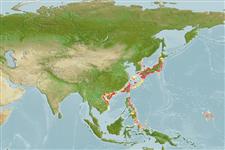>
Kurtiformes (Nurseryfishes, cardinalfishes.) >
Apogonidae (Cardinalfishes) > Pseudamiinae
Etymology: Gymnapogon: Greek, gymnos = naked + Greek, pogon = beard (Ref. 45335).
More on author: Regan.
Environment: milieu / climate zone / depth range / distribution range
Écologie
marin benthopélagique. Tropical
Western Pacific: Japan to the Philippines.
Taille / Poids / Âge
Maturity: Lm ? range ? - ? cm
Max length : 5.0 cm TL mâle / non sexé; (Ref. 559)
Épines dorsales (Total): 7; Rayons mous dorsaux (Total): 10; Épines anales 2; Rayons mous anaux: 9. Body similar to gobioid fishes. No scales on body, but with many well-developed pit organs on head and body. The fan-like caudal fin has many procurrent rays. There is a single downward short spine on the preopercular edge, and many dark-brownish pigments on the caudal peduncle.
Sometimes taken by trawl net, and found in the open sea (Ref. 559).
Life cycle and mating behavior
Maturité | Reproduction | Frai | Œufs | Fécondité | Larves
Distinct pairing during courtship and spawning (Ref. 205).
Masuda, H., K. Amaoka, C. Araga, T. Uyeno and T. Yoshino, 1984. The fishes of the Japanese Archipelago. Vol. 1. Tokai University Press, Tokyo, Japan. 437 p. (text). (Ref. 559)
Statut dans la liste rouge de l'IUCN (Ref. 130435)
Menace pour l'homme
Harmless
Utilisations par l'homme
Pêcheries: sans intérêt
Plus d'informations
PaysZones FAOÉcosystèmesOccurrencesIntroductionsStocksÉcologieRégime alimentaireÉléments du régime alimentaireConsommation alimentaireRation
RéférencesAquacultureProfil d'aquacultureSouchesGénétiqueElectrophoresesHéritabilitéPathologiesTraitementNutrientsMass conversion
CollaborateursImagesStamps, Coins Misc.SonsCiguateraVitesseType de nageSurface branchialeOtolithesCerveauxVision
Outils
Articles particuliers
Télécharger en XML
Sources Internet
Estimates based on models
Preferred temperature (Ref.
123201): 15 - 28.9, mean 25.6 °C (based on 84 cells).
Phylogenetic diversity index (Ref.
82804): PD
50 = 0.5039 [Uniqueness, from 0.5 = low to 2.0 = high].
Bayesian length-weight: a=0.00389 (0.00180 - 0.00842), b=3.12 (2.94 - 3.30), in cm total length, based on all LWR estimates for this body shape (Ref.
93245).
Niveau trophique (Ref.
69278): 3.3 ±0.5 se; based on size and trophs of closest relatives
Résilience (Ref.
120179): Haut, temps minimum de doublement de population inférieur à 15 mois (Preliminary K or Fecundity.).
Fishing Vulnerability (Ref.
59153): Low vulnerability (10 of 100).
